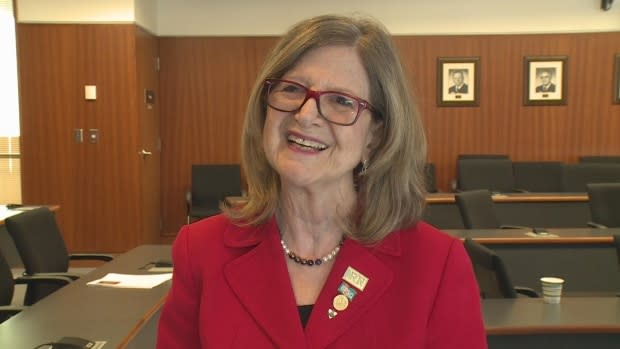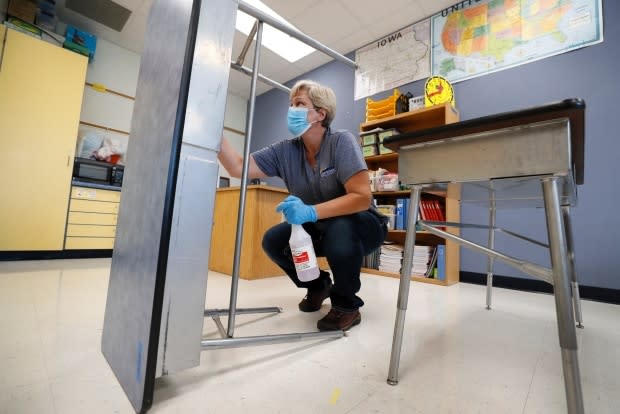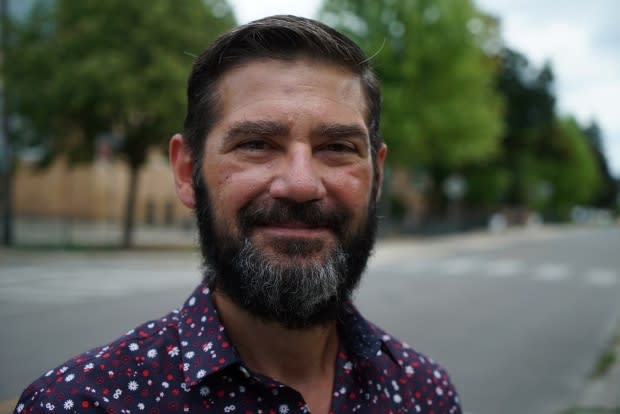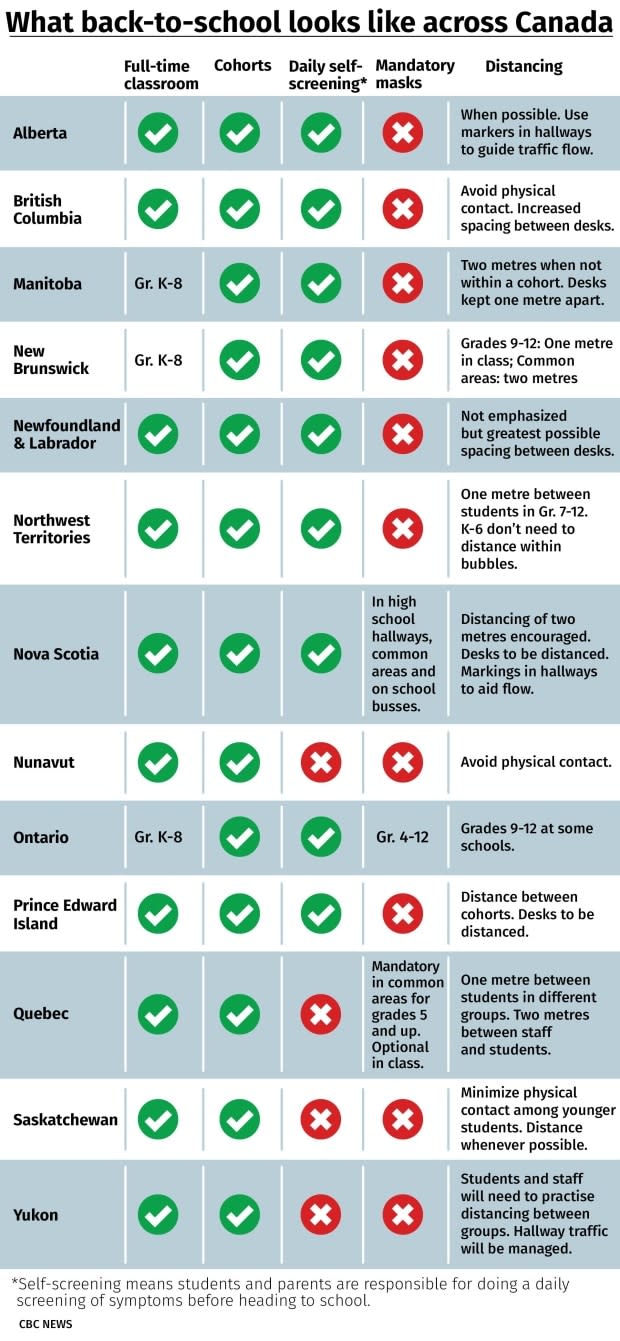School starts in a month, but Canada's most populous province still doesn't know what that will look like

Back to school is imminent for Ontario students, but important elements of exactly how that will look during the COVID-19 pandemic remain up in the air.
Many questions remain about the province's $309 million plan to reopen K-12 schools this fall, with new protocols to be implemented and scores of new staff including teachers, school nurses and custodians who need to be brought on board, trained and deployed.
One notable part of the plan is a $50-million commitment to hire up to 500 school-focused public health nurses. But midway into August, that process is still in the "call-out" stage, Premier Doug Ford admitted on Wednesday.
"We have a call-out right now for nurses. We want to make sure we fulfil the 500 positions without draining from the system," Ford said during his daily news conference.
"Let's get them in the classrooms as soon as possible — even if it takes a couple extra weeks … as long as the 500 nurses are coming."
Details around school nurses still to be ironed out
Details about who is hiring these nurses and where they will be embedded need ironing out, according to Doris Grinspun, CEO of the Registered Nurses' Association of Ontario.
Grinspun, who is among those consulting the province about this part of the plan, welcomes the initiative as a whole, calling the new hires a public health necessity for schools given the complex health concerns that are facing students and teachers going forward.

"We need to be prepared for an outbreak in a school. We need to be prepared for preventing an outbreak," she said.
These nurses, who Grinspun notes would ideally be registered nurses with baccalaureate degrees, would have the expertise to tackle a wide range of issues.
Not only would they adapt to potentially changing COVID-19 conditions this fall and winter, as well as liaise with local public health authorities, but would also tackle flu season and address concerns such as bullying, addiction, anxiety and depression — conditions that may already be exacerbated by the pandemic, Grinspun added.
"This is not only about donning and doffing [masks] … This is about much more than that," she said. "Solving problems [on an ongoing basis], in the context of reopening of schools, it's not simple at all."
Tying this new wave of school nurses to local public health units across the province is also vital, Grinspun said, "to fit the teams on those units and … blend with the rest of the programs" already underway for specific communities.

Custodial staffing levels an ongoing issue, unions say
Another major component of Ontario's plan is $75 million for hiring more than 900 additional custodians and buying cleaning supplies.
But it doesn't go far enough, according to Laura Walton, president of Ontario School Board Council of Unions (OSBCU), which represents 55,000 education workers including custodians and cleaning staff.
"Nine-hundred custodians seems like a lot of people. But you're talking about 4,800 [public elementary and secondary] schools across the province," she said.

"That's not enough for the amount of cleaning that we need to do for our students," Walton said, adding that the issue of too few staffers to clean and maintain Ontario public schools has been a perennial issue and was raised during contract negotiations last year.
Walton said she has heard from OSBCU locals about custodial job postings going up in various regions.
She also predicts that, as a first measure, school boards likely will tap their existing casual supply lists to offer those workers permanent employment.
"These are decent paying jobs and so hopefully we will have folks come forward interested," she said. "There is going to be a lot of work."

'Trying to put a puzzle together'
Boards have been working on reopening scenarios for months.
"We've been at this since really, the beginning of May," noted Peter Sovran, associate director of learning services for the Hamilton-Wentworth District School Board (HWDSB) and chair of its back-to-school planning group.
His team has been planning how to reopen following the latest pandemic guidelines as well as the board's standard budget allocation from the province.
Sovran says they've been guided by a number of key principles, including student and staff safety, minimizing disruption to regular school routines and flexibility between conventional, adaptive or remote learning if COVID conditions change quickly.
WATCH l Epidemiologist answers questions about heading back to school:
They've also looked at the financial support needed for scenarios such as reducing class sizes.
Since the province announced its decision to keep elementary class sizes at pre-COVID levels, various health officials, parents and educators have reiterated the call for a drastic reduction to facilitate in-class physical distancing.
However, with just weeks to go before school starts, a major reduction to class sizes across HWDSB elementary schools alone would be a complex endeavour, Sovran explained.

According to an updated HWDSB report released Monday, 15-student classes would require about 900 additional teachers at the cost of approximately $76 million. The province has thus far pledged $30 million for the hiring of additional teachers across all of Ontario.
Funding for new teachers aside, Sovran said other logistical considerations if class sizes were reduced include identifying additional classroom spaces, implementing health and safety requirements for those locations and putting necessary resources into them, as well as figuring out which students will be reassigned to what schools and how to get them there.
While HWDSB has already learned of some additional provincial funding headed its way — $1.2 million to hire more custodians, for instance — officials are still awaiting many more details.
"It's trying to put a puzzle together and sometimes all the pieces aren't there or partway through, the pieces of the puzzle change. Trying to fit them together sometimes is a real challenge," Sovran said.
"Has it been stressful? Probably like no other time in any of our careers."
No perfect solution, Ford says
Amid ongoing criticism of Ontario's back-to-school plan, Premier Doug Ford and Minister of Education Stephen Lecce have repeatedly cited the need for flexibility to remain "responsive" to COVID conditions across the province.

"We have to be flexible when it comes to education … it doesn't mean that everything will be perfect," Ford noted on Wednesday.
An announcement regarding "improvements" to the back-to-school plan is forthcoming, Ford said, adding there would be no significant changes.
"We're just going to continue working at the process and always improving it. I've never believed in just saying 'OK, that's it. Here, it's done.' "

